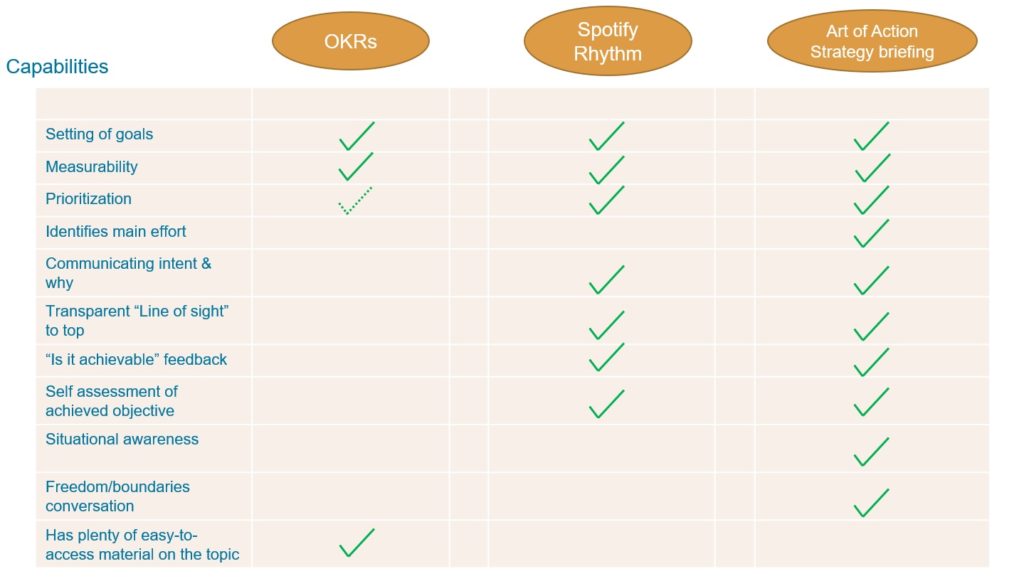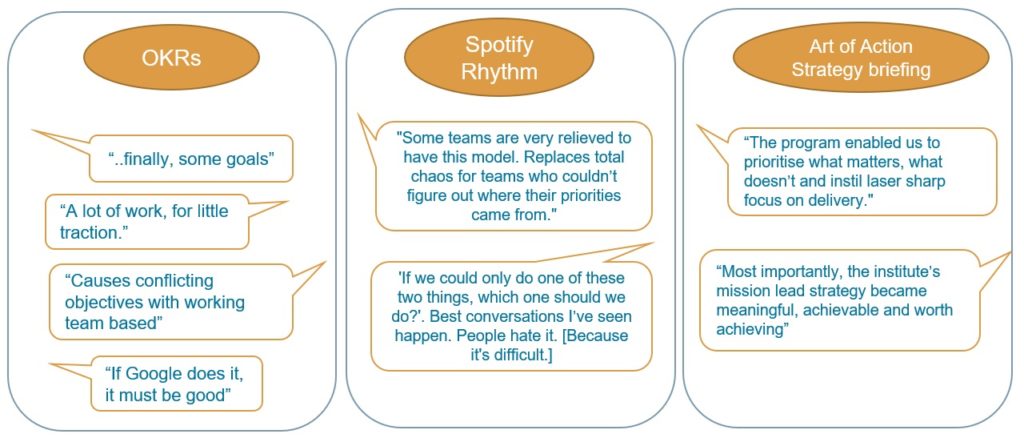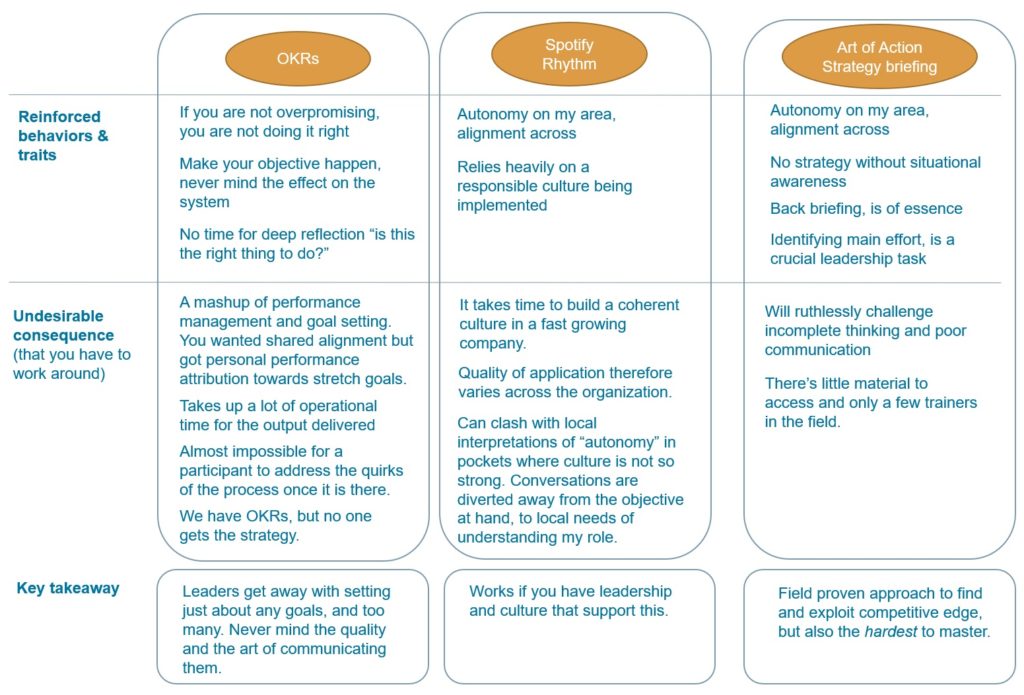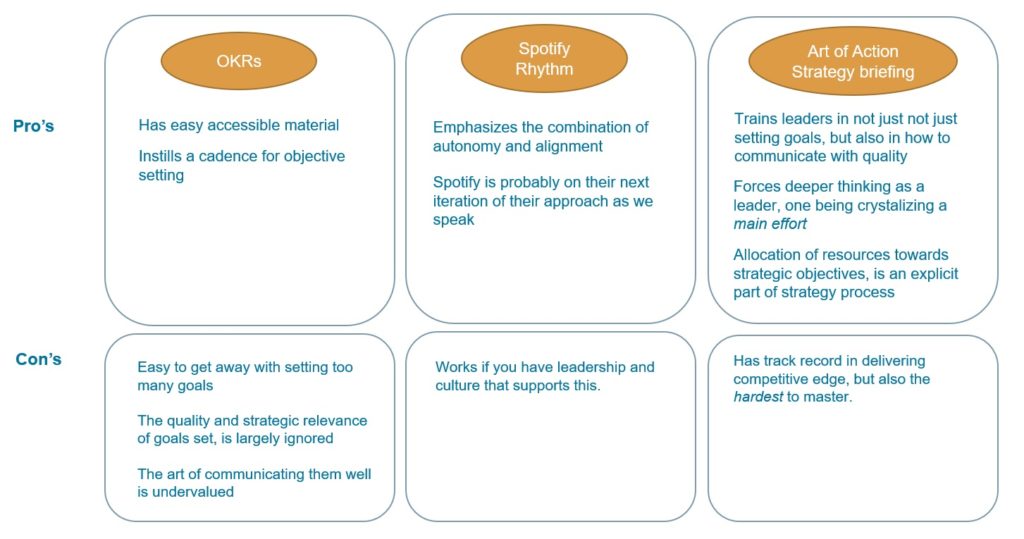A downloadable version of this article can be found here.
One of the strongest management trends right now in companies striving towards Agile is undoubtedly OKRs, “Objectives and Key Results”.
But how do OKRs stack up against the alternatives when it comes to alignment frameworks? And what are the potential undesirable behaviors that come with them?
That is what I intend to explore in this article.
Different strategy deployment frameworks
There are a few strategy deployment frameworks you can lean on. For this article, I’ve chosen to focus on three:
- OKRs. The development of OKRs is generally attributed to Andy Grove (“father of OKRs”) who used it at Intel in the early 80’s. The cited implementation today is Google. The roots of OKRs stem from Peter Drucker’s Management by Objectives.
- Spotify Rhythm. Spotify borrowed lessons learned from OKRs when they implemented their approach. It’s worth mentioning that Spotify also borrowed heavily from Bungay’s Art of Action (see below). Note that Spotify has iterated their alignment framework at least three times. Why? You might ask. Well that’s where it gets interesting :)!
- Art of Action Strategy Briefing. Stephen Bungay’s strategy execution framework has its roots in maneuver warfare, where commanders face having to outmaneuver competition under fluid and uncertain conditions. While still the lesser-known framework, it has merit when it comes to creating competitive edge. It has been most famously put to use by the Mercedes Formula 1 racing team.
The reason for picking these three frameworks is that all of these have been applied within IT/product development and, with varying outcomes, also with Agile teams. There are runners-up that I decided not to focus on here mostly because they aren’t as frequently encountered in IT nor in fast-growing companies. The most notable runner-up worth a mention would be Hoshin Kanri from Toyota.
A little bit about the method
I wrote this article in order to summarize observations from 4 tech companies who apply OKRs in some shape or form. The observations from Spotify Rhythm come from a few colleagues who have worked there to help out in the implementation.
Insights from Art of Action are based on articles and interviews with people applying it, plus observations from studying the approach and by interviewing the author, Stephen Bungay.
Variations always exist related to context. Each company has its own unique experiences. My point is not to produce a picture which accurately maps every possible implementation, but rather to extract a few key insights across multiple implementations which would otherwise be quite hard to come by.
Read this to learn, think, and reflect. Then decide what is best for you in your particular context. That said, let’s jump directly into the capability overview.
A capability overview of alignment frameworks
For a capability to be considered supported, it has to pass two tests: (1) It has to have an artifact that supports making it happen, and (2) it can’t be random. In other words, intentions, without a process to realize them, do not merit a mark in the matrix below

A few words on key capabilities deserving elaboration
I hope most of the capabilities above are self-explanatory. There are however a few that deserve elaboration. Let us take a look at them:
| Line of sight | The ability for a team to see how their objective relates all the way up to the top. This is key to enabling teams to identify and challenge faulty assumptions and suggest better approaches. |
| “Is it achievable” feedback | Feedback from the people realizing the objective by asking the question – “is it achievable?” The consequence of not having it is a broken feedback loop. The commander risks living in an artificial reality. |
| Situational awareness | Observing the landscape around you before looking inside your company. An example would be to look at the market and the movement inside the competitive landscape before looking inside your company. |
| Freedom/Boundaries conversations | The result is clarity of freedoms and boundaries – a clear transfer of decision-making ’power’ from one level of management to another. The classic management ‘breach’ of this is demanding responsibility without conferring decision making authority. |
Comments from real people
To add another angle, let’s take a look at comments from people who have practical experience applying the frameworks:

What are the potential undesirable consequences?
I will start by stating two axioms about the relationship between process and culture:
Axiom 1: Process impacts culture. Therefore, the cultural implications can’t be ignored when you implement a process. Case in point: Implementing an Agile mindset through RUP won’t fly – not because RUP potentially could work, but because RUP drives a prescriptive ‘tick the boxes’ mindset. Another example: If the process is too heavy, people are going to ignore it regardless of any good intentions.
Axiom 2: If leaders talk about a desired culture, but processes tell a completely different story, the trust capital you carry makes leaders weaker. “You say this but you do that”. This matters because trust capital is hard currency for fearlessly confronting and overcoming situations of uncertainty.
If you believe that there is some truth to these axioms, then feel free to dive into the potential undesirable consequences that come with each framework:

Let’s dive deeper into some of the points above.
OKRs
| Explanation | Implication | |
|---|---|---|
| A mashup of performance management and goal setting. You wanted shared alignment but got personal performance attribution towards stretch goals. | You might say OKRs don’t tell you to make this a part of personal performance attribution. But in reality, it does become it. It is simply too tempting to ignore. | You get a process which tells a different message compared to an Agile culture. Do you want individual heroes or teamwork? People will see this and be confused. |
| If you are not overpromising you are not doing it right | In OKR goal setting, you are expected to set near impossible stretch goals. | What is the potential undesirable consequence? First: Does an organization really need more work? Second: What is the net effect of setting stretch goals on your organization’s ability to cleverly allocate resources to the areas where they can make a difference? Let’s take a bottleneck as an example: Should it attempt to achieve what the bottleneck considers a stretch goal, or what everyone else considers a stretch goal, or… (you get the point). All organizations with limited resources must carefully consider where they spend them. This is part of the strategy. Confusion as to what the critical effort should really be is bad since it slows down this process. Third: Do you need stretch goals because you don’t really trust that your highly skilled people would do a good job? My point of view is that if you think you need stretch goals for people to do, to give it their best, you have failed to create a highly motivating environment in the first place. Grasping for stretch objectives to ensure motivation just cloaks this fact. |
Spotify Rhythm
| Explanation | Implication | |
|---|---|---|
| Autonomy in my area alignment across | In the base setup, a high degree of decentralized decision making is given. This is part of the careful design of the organization. | The main bulk of what gets done is driven by decentralized decision making. The alignment is simply a portion on top. |
| Quality of application of alignment varies across the organization | With culture being a central part of the governance, weaker spots of culture will be areas where the alignment process repeatedly runs into friction. | Conversations constantly being digressed from “what do we need to do to achieve the company objective” to more urgent local needs (unsatisfactorily answered) – like “what is my role and what are my mandates?” |
Art of Action Strategy Briefing
| Explanation | Implication | |
|---|---|---|
| Will ruthlessly challenge incomplete thinking and poor communication. | A central cornerstone in the Art of Action approach is the back-briefing process. | As a leader, you need to work with your objective until it is clearly communicated and people understand what it really means for them. Back-briefing is a feedback mechanism that rapidly highlights the quality of our communication. |
Summing it up

Let’s start by saying that having an alignment framework if you are in a scaled scenario is certainly better than not having one.
That said, you should be aware of the alternatives and the pros and cons of each. A perspective to consider: Not only the process, but also which behaviors the process brings. Behaviors shape your culture. A strategy alignment process will have a company-wide cultural impact. So, you do need to ask yourself: Does the process represent the culture you want as a leader?
You can of course work around each drawback, but my practical experience tells me that this is often brushed over due to time pressure.
Spotify Rhythm requires a long-term commitment to build a Spotify culture.
OKRs are an easy stepping stone and where most tech companies begin. However, the quality aspects of the goals set are largely overlooked. OKRs put a lot of emphasis on the measurement of goals. While using data is a good thing, with the over-emphasis on measuring and the under-emphasis on the clarity of direction leads to celebrating false precision. What does it matter that you can measure your goal, if it is the wrong one, a goal with marginal strategic importance in which few really believe in? This should raise some concerns since you are practically betting your company on the goals you set.
If I were to compare them as tools, OKRs are like a sledgehammer whereas Art of Action strategy briefing is more like a scalpel – the precision and the lightweight make it a good fit for Agile strategy.
Art of Action strategy briefing asks many of the key questions you need in an alignment process. However, you need to be committed to stick with it for some time to get the implementation right. This is the investment needed to build the competence in leaders to be able to handle the process.
So, what to do? Well, hopefully this article has helped you see a few areas of improvement. A good place to start is to arm yourself with understanding.
Start by learning how your current alignment process is perceived by running an honest retrospective with participants from multiple levels.
Read Stephen Bungay’s The Art of Action. Attend a class. Look outside your company and learn from the best.
If you are good with the behaviours, then steal the best ideas and improve from the process above. Mastery is the craft of continuously upping your game.
– Mattias Skarin, 2020




Great article, but it would be good with a brief explanation of each of the three alternatives. E.g., what does the “Spotify rhythm” entail?
I agree, that could be a follow article to walk through each in more depth. I tried to share a few links in the beginning of the article to aid the person who wants to dig further into each.
I added 4DX and my TASTE X-Matrix into the mix here:
https://availagility.co.uk/2020/05/28/comparing-strategy-alignment-frameworks/
Nice! Also – for you who would like to know more about Spotify Rhythm – Karl has made a summary: https://availagility.co.uk/2016/07/11/strategy-deployment-and-spotify-rhythm/
Mattias – I read Bungay’s work a couple of years ago. It is well written but lacked enough depth/examples for me to make it concrete. You recommend taking a course – who offers one? Bungay doesn’t and I have yet to find another.
We had one planned for last spring, so it’s on the todo list. Give me a ping over email and I’ll let you know when it’s online.
Cheers Mattias
Hi Mattias, have you looked at the rockefeller habits and the book Scaling Up? I think it might check a lot of your boxes. Nice blog by the way! Keep it up 🙂
Not yet, but will look it up. Cheers Mattias
I have done a quick readthrough of the material I could find. Take this with a grain of salt since I haven’t been able to validate with real implementations.
There are many overlappning habits that appear in both Rockefellar habits, Rhythm, and Art of action (thankfully).
The main missing aspect in Rockefeller habits is valuing Thinking people. It’s very heavy on top down, very weak on bottom up. The Backbreif approach, in Art of action is the counter example of a communication loop that does just that. So a little bit blunt, Rockerfeller is geard towards “process over people” over “people over process”. This will make it brittle when situation changes.